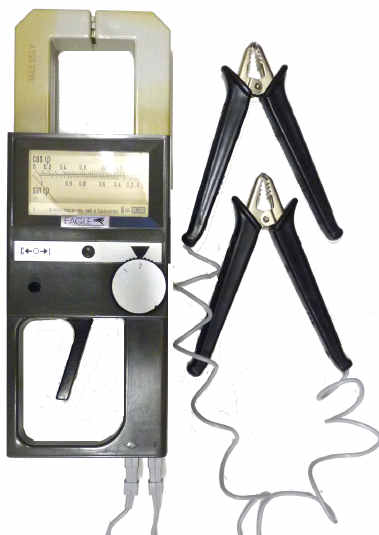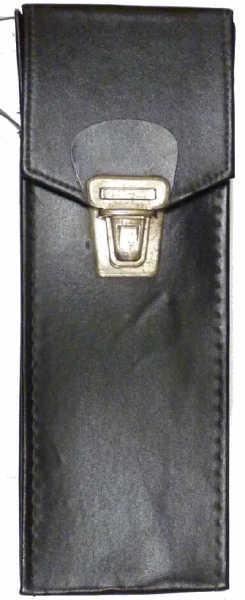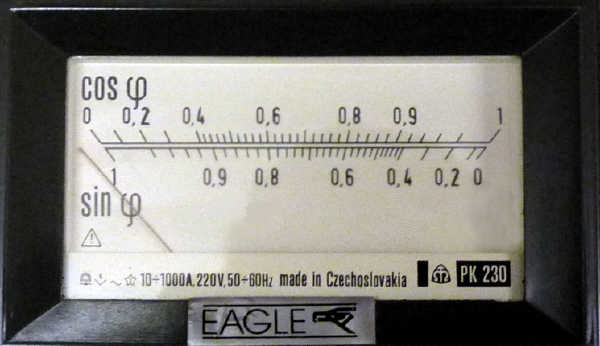



Eagle PK230 Clamp Phase meter 10 to 1000 Amps 220 Volts AC supply. Working, manufactured in Czechoslovakia in about 1970?. This is one of many instruments collected by Jack Davidson C Eng FIEE which I have been given by Dr Graham Winbolt.

close up view of scale
This instrument is used for power-factor measurement in a single-phase network with voltage of 220 V in current ranges 10-1000 A. It is suitable especially for assembly, maintenance and repair shops, when electrical equipment and power-consuming appliances are handled. The measured circuit need not be disconnected during measurement, as the measured conductor is encompassed by the jaws of the clip-on transformer.
Two test cords with crocodile clamps and sockets are supplied with the instrument in a protective bag. These are terminated with a special plug and socket are inserted into holes in the bottom part of the handle, in which banana pins are located. The voltage input is marked by an arrow and output by the, letter V. The other end of the test cords - the crocodile clamp - is connected to the conductor with phase voltage. The measured conductor is encircled by the jaws. The position of the conductor inside the jaws has only slight influence on the accuracy of the instrument. The jaws must be fully closed and should not touch the conductor. If the pointer of the instrument shows below zero, the selector switch marked with position 1 and 2 should be changed over. This reverses the polarity and eliminates the need of interchanging the polarity of the voltage supply. The instrument dial has two straight-line scales. The upper scale is-calibrated directly in cos Φ values. The bottom scale is derived from the upper one and indicates sin Φ value. The loading character can be determined from the change of pointer position during the measurement after pressing the push-button of the instrument. If on pressing the push-button the pointer deflection is greater than that shown during the measurement the load is capacitive, if it is smaller, the load is inductive. The loading character is indicated on the nameplate by arrows. The measurement can be carried out even in inaccessible places where the dial reading is difficult, as the deflection can be arrested at any point on the scale by the locking slide switch on the right hand side of the instrument. The instrument should not be stored with locked pointer.
After each measurement of power factor at higher current values and prior to further measurement of a lower range it is essential to open and close the jaws several times (min. 3 X) after taking the instrument off the conductor. This is to remove any remanent magnetism and avoid additional errors which would reduce the accuracy of the instrument beyond its accuracy class. The measured current conductor must be a single strand, i.e. when a single-phase circuit is measured the jaws must not encircle both conductors, or in a three phase measurement all three or four conductors. The measured conductor can be insulated and enclosed in a metal conduit.
Do not put off and store the instruments with locked pointer.
cos Φ from 0 to 1 [Leading or lagging] on a single-phase 220 V
network with currents from 10 to 1000 A
Class of accuracy 5
AC supply frequency 50-60 Hz
Test voltage 2000 V
Max. conductor dimensions 50 mm diameter or 50X60 mm rectangular
Click here for instruction leaflet
During the 1960s and 70s, Eagle International were distributors of
Eagle Products which included audio, amateur radio and test equipment
which were mainly made in Japan. Their products were sold to dealers
who then sold to the public. I understand that Eagle sold meters made
for them by KEW. Gerry Adler who was the managing director of Eagle
International previously had a business in the 1950s called Relda in
Tottenham Court Road, London W1 which like many others sold radio and
audio components and equipment.
The Head Office was at Eagle International Precision Centre, Heather
Park Drive, Wembley, HA0 1SU Middlesex.
The service Department at the time this instrument was made was: Eagle
International, Unit 5, Royal London Estate, 29-35 North Acton Road,
London NW10 6PE. The premises are currently [2012] occupied by
theatrical costume suppliers.

